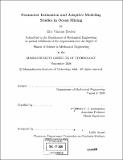| dc.contributor.advisor | Pierre F. J. Lermusiaux. | en_US |
| dc.contributor.author | Heubel, Eric Vincent | en_US |
| dc.contributor.other | Massachusetts Institute of Technology. Dept. of Mechanical Engineering. | en_US |
| dc.date.accessioned | 2009-06-30T17:29:41Z | |
| dc.date.available | 2009-06-30T17:29:41Z | |
| dc.date.copyright | 2008 | en_US |
| dc.date.issued | 2008 | en_US |
| dc.identifier.uri | http://hdl.handle.net/1721.1/46155 | |
| dc.description | Thesis (M. Eng.)--Massachusetts Institute of Technology, Dept. of Mechanical Engineering, 2008. | en_US |
| dc.description | Includes bibliographical references (p. 119-121). | en_US |
| dc.description.abstract | In this thesis, we explore the different methods for parameter estimation in straightforward diffusion problems and develop ideas and distributed computational schemes for the automated evaluation of physical and numerical parameters of ocean models. This is one step of "adaptive modeling." Adaptive modeling consists of the automated adjustment of self-evaluating models in order to best represent an observed system. In the case of dynamic parameterizations, self-modifying schemes are used to learn the correct model for a particular regime as the physics change and evolve in time. The parameter estimation methods are tested and evaluated on one-dimensional tracer diffusion problems. Existing state estimation methods and new filters, such as the unscented transform Kalman filter, are utilized in carrying out parameter estimation. These include the popular Extended Kalman Filter (EKF), the Ensemble Kalman Filter (EnKF) and other ensemble methods such as Error Subspace Statistical Estimation (ESSE) and Ensemble Adjustment Kalman Filter (EAKF), and the Unscented Kalman Filter (UKF). Among the aforementioned recursive state estimation methods, the so-called "adjoint method" is also applied to this simple study. Finally, real data is examined for the applicability of such schemes in real-time forecasting using the MIT Multidisciplinary Simulation, Estimation, and Assimilation System (MSEAS). The MSEAS model currently contains the free surface hydrostatic primitive equation model from the Harvard Ocean Prediction System (HOPS), a barotropic tidal prediction scheme, and an objective analysis scheme, among other models and developing routines. The experiment chosen for this study is one which involved the Monterey Bay region off the coast of California in 2006 (MB06). Accurate vertical mixing parameterizations are essential in this well known upwelling region of the Pacific. In this realistic case, parallel computing will be utilized by scripting code runs in C-shell. The performance of the simulations with different, parameters is evaluated quantitatively using Pattern Correlation Coefficient, Root Mean Squared error, and bias error. Comparisons quantitatively determined the most adequate model setup. | en_US |
| dc.description.statementofresponsibility | by Eric Vincent Heubel. | en_US |
| dc.format.extent | 121 p. | en_US |
| dc.language.iso | eng | en_US |
| dc.publisher | Massachusetts Institute of Technology | en_US |
| dc.rights | M.I.T. theses are protected by
copyright. They may be viewed from this source for any purpose, but
reproduction or distribution in any format is prohibited without written
permission. See provided URL for inquiries about permission. | en_US |
| dc.rights.uri | http://dspace.mit.edu/handle/1721.1/7582 | en_US |
| dc.subject | Mechanical Engineering. | en_US |
| dc.title | Parameter estimation and adaptive modeling studies in ocean mixing | en_US |
| dc.type | Thesis | en_US |
| dc.description.degree | M.Eng. | en_US |
| dc.contributor.department | Massachusetts Institute of Technology. Department of Mechanical Engineering | |
| dc.identifier.oclc | 399635168 | en_US |
